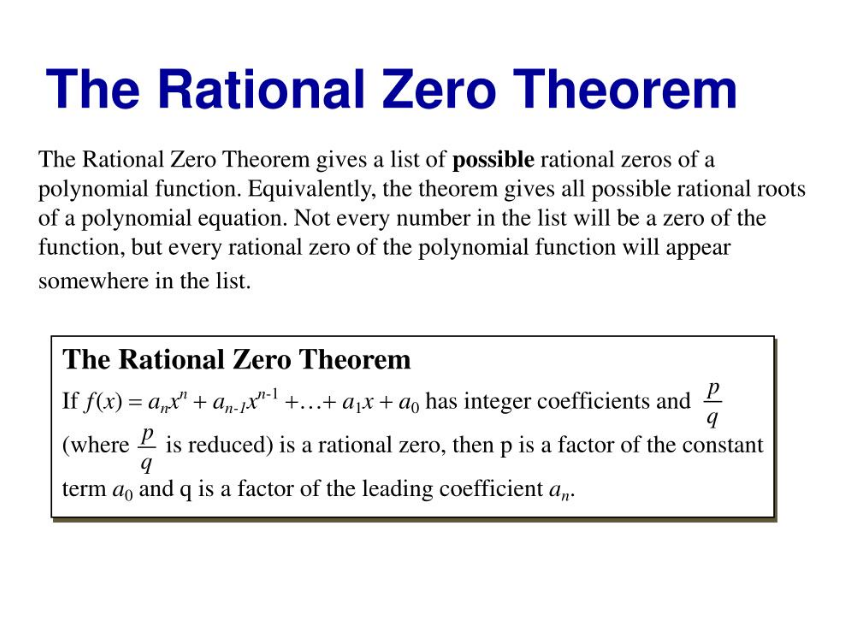Table of Contents
Roots of a Polynomial
A root or zero of a function is a number that, when plugged in for the variable, makes the function equal to zero. Thus, the roots of a polynomial P(x) are values of x such that P(x) = 0.

The Rational Zeros Theorem
The Rational Zeros Theorem states:
IfP(x)is a polynomial with integer coefficients and if
is a zero of P(x)(P(
) = 0), thenpis a factor of the constant term ofP(x)andqis a factor of the leading coefficient of P(x).
We can use the Rational Zeros Theorem to find all the rational zeros of a polynomial. Here are the steps:
- Arrange the polynomial in descending order
- Write down all the factors of the constant term. These are all the possible values of p.
- Write down all the factors of the leading coefficient. These are all the possible values of q.
- Write down all the possible values of
 . Remember that since factors can be negative,
. Remember that since factors can be negative,  and –
and –  must both be included. Simplify each value and cross out any duplicates.
must both be included. Simplify each value and cross out any duplicates. - Use synthetic division to determine the values of
 for which P(
for which P( ) = 0. These are all the rational roots of P(x).
) = 0. These are all the rational roots of P(x).
Example: Find all the rational zeros of P(x) = x3 -9x + 9 + 2x4 -19x2.
- P(x) = 2x4 + x3 -19x2 – 9x + 9
- Factors of constant term: ±1, ±3, ±9.
- Factors of leading coefficient: ±1, ±2.
- Possible values of
 : ±
: ± , ±
, ± , ±
, ± , ±
, ± , ±
, ± , ±
, ± . These can be simplified to: ±1, ±
. These can be simplified to: ±1, ± , ±3, ±
, ±3, ± , ±9, ±
, ±9, ± .
. - Use synthetic division:
Figure %: Synthetic Division
Thus, the rational roots of P(x) are x = – 3, -1,  , and 3.
, and 3.
We can often use the rational zeros theorem to factor a polynomial. Using synthetic division, we can find one real root a and we can find the quotient when P(x) is divided by x – a. Next, we can use synthetic division to find one factor of the quotient. We can continue this process until the polynomial has been completely factored.
Example (as above): Factor P(x) = 2x4 + x3 -19x2 – 9x + 9.
As seen from the second synthetic division above, 2x4 + x3 -19x2 -9x + 9÷x + 1 = 2x3 – x2 – 18x + 9. Thus, P(x) = (x + 1)(2x3 – x2 – 18x + 9). The second term can be divided synthetically by x + 3 to yield 2x2 – 7x + 3. Thus, P(x) = (x + 1)(x + 3)(2x2 – 7x + 3). The trinomial can then be factored into (x – 3)(2x – 1). Thus, P(x) = (x + 1)(x + 3)(x – 3)(2x – 1). We can see that this solution is correct because the four rational roots found above are zeros of our result.
